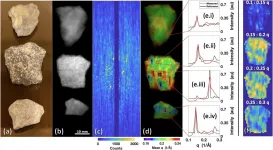(Press-News.org) The widely studied metallic asteroid known as 16 Psyche was long thought to be the exposed iron core of a small planet that failed to form during the earliest days of the solar system. But new University of Arizona-led research suggests that the asteroid might not be as metallic or dense as once thought, and hints at a much different origin story.
Scientists are interested in 16 Psyche because if its presumed origins are true, it would provide an opportunity to study an exposed planetary core up close. NASA is scheduled to launch its Psyche mission in 2022 and arrive at the asteroid in 2026.
UArizona undergraduate student David Cantillo is lead author of a new paper published in The Planetary Science Journal that proposes 16 Psyche is 82.5% metal, 7% low-iron pyroxene and 10.5% carbonaceous chondrite that was likely delivered by impacts from other asteroids. Cantillo and his collaborators estimate that 16 Psyche's bulk density - also known as porosity, which refers to how much empty space is found within its body - is around 35%.
These estimates differ from past analyses of 16 Psyche's composition that led researchers to estimate it could contain as much as 95% metal and be much denser.
"That drop in metallic content and bulk density is interesting because it shows that 16 Psyche is more modified than previously thought," Cantillo said.
Rather than being an intact exposed core of an early planet, it might actually be closer to a rubble pile, similar to another thoroughly studied asteroid -- Bennu. UArizona leads the science mission team for NASA's OSIRIS-REx mission, which retrieved a sample from Bennu's surface that is now making its way back to Earth.
"Psyche as a rubble pile would be very unexpected, but our data continues to show low-density estimates despite its high metallic content," Cantillo said.
Asteroid 16 Psyche is about the size of Massachusetts, and scientists estimate it contains about 1% of all asteroid belt material. First spotted by an Italian astronomer in 1852, it was the 16th asteroid ever discovered.
"Having a lower metallic content than once thought means that the asteroid could have been exposed to collisions with asteroids containing the more common carbonaceous chondrites, which deposited a surface layer that we are observing," Cantillo said. This was also observed on asteroid Vesta by the NASA Dawn spacecraft.
Asteroid 16 Psyche has been estimated to been worth $10,000 quadrillion (that's $10,000 followed by 15 more zeroes), but the new findings could slightly devalue the iron-rich asteroid.
"This is the first paper to set some specific constraints on its surface content. Earlier estimates were a good start, but this refines those numbers a bit more," Cantillo said.
The other well-studied asteroid, Bennu, contains a lot of carbonaceous chondrite material and has porosity of over 50%, which is a classic characteristic of a rubble pile.
Such high porosity is common for relatively small and low-mass objects such as Bennu - which is only as large as the Empire State Building - because a weak gravitational field prevents the object's rocks and boulders from being packed together too tightly. But for an object the size of 16 Psyche to be so porous is unexpected.
"The opportunity to study an exposed core of a planetesimal is extremely rare, which is why they're sending the spacecraft mission there," Cantillo said, "but our work shows that 16 Psyche is a lot more interesting than expected."
Past estimates of 16 Psyche's composition were done by analyzing the sunlight reflected off its surface. The pattern of light matched that of other metallic objects. Cantillo and his collaborators instead recreated 16 Psyche's regolith - or loose rocky surface material - by mixing different materials in a lab and analyzing light patterns until they matched telescope observations of the asteroid. There are only a few labs in the world practicing this technique, including the UArizona Lunar and Planetary Laboratory and the Johns Hopkins Applied Physics Laboratory in Maryland, where Cantillo worked while in high school.
"I've always been interested in space," said Cantillo, who is also president of the UArizona Astronomy Club. "I knew that astronomy studies would be heavy on computers and observation, but I like to do more hands-on kind of work, so I wanted to connect my studies to geology somehow. I'm majoring geology and minoring in planetary science and math."
"David's paper is an example of the cutting-edge research work done by our undergraduate students," said study co-author Vishnu Reddy, an associate professor of planetary sciences who heads up the lab in which Cantillo works. "It is also a fine example of the collaborative effort between undergraduates, graduate students, postdoctoral fellows and staff in my lab."
The researchers also believe the carbonaceous material on 16 Psyche's surface is rich in water, so they will next work to merge data from ground-based telescopes and spacecraft missions to other asteroids to help determine the amount of water present.
INFORMATION:
[RALEIGH, N.C.] - How are the squirrels doing this year? The bears? The armadillos? How would you know? A new paper published June 8 sets up the framework for answering these questions across the United States by releasing the data from the first national mammal survey made up of 1,509 motion-activated camera traps from 110 sites located across all 50 states.
Unlike birds, which have multiple large-scale monitoring programs, there has been no standard way to monitor mammal populations at a national scale. To address this challenge, scientists from the North Carolina Museum of Natural Sciences and the Smithsonian Conservation Biology Institute recently collaborated ...
DURHAM, N.C. - Engineers at Duke University have demonstrated a prototype X-ray scanning machine that reveals not just the shape of an object but its molecular composition. With unprecedented resolution and accuracy, the technology could revolutionize a wide range of fields such as cancer surgery, pathology, drug inspection and geology.
Many of the ideas behind the prototype were originally conceived in the pursuit of performing better bomb detection for aviation security. In the new paper, published online May 19 in the journal Scientific Reports, the researchers adapted the technology for several targeted scientific and medical applications.
"Whether you're trying to spot a bomb in a bag or a tumor in a body, the physics is more or less the same," said ...
Watching honeybees buzz among flowers, it's easy to see how the expression "busy as a bee" arose. One of many movements a bee's body makes is the repetitive curving and straightening of its abdomen. Now, researchers reporting in ACS Applied Materials & Interfaces have found that tiny hairs reduce friction from these motions, saving energy for the industrious insects' daily activities while reducing wear and tear. This knowledge could help researchers design longer-lasting moving parts.
A bee's abdomen is divided into several tough outer plates that make up its exoskeleton. When the abdomen flexes and extends, these segments slide over each other, creating friction. However, the overlapping portions of the segments show very little wear and tear, ...
WASHINGTON, June 9, 2021 -- The World Health Organization and the Centers for Disease Control recommend keeping a certain distance between people to prevent the spread of COVID-19. These social distancing recommendations are estimated from a variety of studies, but further research about the precise mechanism of virus transport from one person to another is still needed.
In Physics of Fluids, by AIP Publishing, researchers from Stony Brook University, Harvard, ETH Zurich, and Hanyang University demonstrate normal breathing indoors without a mask ...
Summer rainfall on the Tibetan Plateau is highly predictable on multiyear timescales in large ensemble predictions, according to a research team led by ZHOU Tianjun from the Institute of Atmospheric Physics (IAP) of the Chinese Academy of Sciences.
The study, published in Science Advances on June 9, shows evidence that the predictable signal of summer rainfall across the hinterland of the Tibetan Plateau is substantially underestimated in state-of-the-art decadal prediction models.
The predictable signal is so weak that it can be concealed by unpredictable noise. "The too weak predictable signal arises from the low signal-to-noise ratios in models in comparison with the real world," ...
A new study at the University of Chicago Medicine and Washington University found that a single inhalation session with 25% nitrous oxide gas was nearly as effective as 50% nitrous oxide at rapidly relieving symptoms of treatment-resistant depression, with fewer adverse side effects. The study, published June 9 in Science Translational Medicine, also found that the effects lasted much longer than previously suspected, with some participants experiencing improvements for upwards of two weeks.
These results bolster the evidence that non-traditional treatments may be a viable option for patients whose depression is not responsive to typical antidepressant medications. It may also provide a rapidly effective treatment option for patients in crisis.
Often called "laughing gas," nitrous ...
A single, one-hour treatment that involves breathing in a mixture of oxygen and nitrous oxide -- otherwise known as laughing gas -- significantly improved symptoms in people with treatment-resistant depression, according to new data from researchers at Washington University School of Medicine in St. Louis and the University of Chicago.
In a phase 2 clinical trial, the researchers demonstrated that symptoms of depression improve rapidly following treatment with inhaled nitrous oxide. Further, they reported the benefits can last for several weeks.
The findings are published June 9 in the journal Science Translational Medicine.
"A large percentage of patients don't respond to standard antidepressant therapies -- the ...
A new study unexpectedly identified tiny deposits of elemental copper and iron within the brains of two deceased people with Alzheimer's disease. The findings could help scientists better understand how these elemental metals, which were uncovered in the cores of amyloid plaques, contribute to neurodegenerative diseases and could point to a target for alternative Alzheimer's therapies. While enzymes and proteins containing positively charged copper and iron ions have been known to control key processes in the human brain, little has been known about how the organ mineralizes iron and copper, including the formation of elemental metallic nanoparticles, which ...
(Boston)--Should treatment of alcoholics be different based on gender? Yes, according to a new study that shows that alcoholic men and women respond differently to their disease resulting in different levels of brain activity and brain abnormalities. Research indicates that they distinguish facial expressions differently and that this is an important clue as to how treatment strategies might be tailored.
Chronic long-term Alcohol Use Disorder (AUD) or "alcoholism," is a harmful condition that has been associated with deficits in emotion and memory, including memory for the emotional expressions of faces. In addition to its effects on memory for facial emotions, AUD also has been associated with impairments ...
PSI researchers have developed a new tomography method with which they can measure chemical properties inside catalyst materials in 3-D extremely precisely and faster than before. The application is equally important for science and industry. The researchers published their results today in the journal Science Advances.
The material group of vanadium phosphorus oxides (VPOs) is widely used as a catalyst in the chemical industry. VPOs have been used in the production of maleic anhydride since the 1970s. Maleic anhydride in turn is the starting material for the ...





